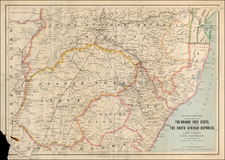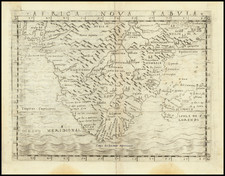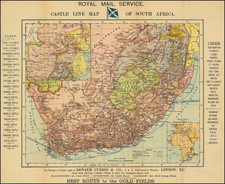Dutch Sea Chart of the Cape of Good Hope
Detailed early sea chart of the South African coast extends from Cape Negro to The Cape of Good Hope, with an inset map of The Cape of Good Hope which shows Table Mount and a second inset map of Vlees Bay.
Oriented with east at the top, the map one of the earliest detailed maps of the region and illustrates the growth of the Dutch Colony in the second half of the 17th Century, following the establishment of the free burgher system in the region and expansion of the local population.
Norwich describes the chart as a fine, decisive copperplate engraved map with a great deal of detail of the coastline from the Cape of Good Hope in the south to Cape Negro in the North. An identical sea chart, attributed to Jodocus Hondius, appeared in a rare pamphlet in 1652 which described the European holdings in South Africa the year Van Riebeeck landed in Table Bay.
Cape Town / Cape of Good Hope
The area around Cape Town, known historically as the Cape of Good Hope, holds a significant position in the annals of both South African and global history. In the 17th century, this strategic location emerged as a critical waypoint in the Dutch maritime empire.
During the age of exploration and colonial expansion, European powers were eager to establish trade routes to the East Indies. For the Dutch East India Company (Vereenigde Oostindische Compagnie, VOC), founded in 1602, controlling the cape became essential for maintaining a supply chain to its trading posts in Asia. In 1652, under the leadership of Jan van Riebeeck, the VOC established a victualing station at the Cape to service its fleets. This foothold would develop into the town of Cape Town, becoming the first permanent European settlement in South Africa.
The indigenous Khoisan peoples, comprising the Khoi pastoralists and San hunter-gatherers, initially engaged with the settlers through trade and labor. However, as the Dutch settlement expanded, land dispossession and the introduction of European farming practices led to the marginalization and displacement of the Khoisan communities. The introduction of slaves from Indonesia, Madagascar, and other parts of Africa by the VOC added to the ethnic and cultural tapestry of the Cape but also entrenched a brutal system of slavery and social stratification. Slavery was officially sanctioned by the VOC in 1658, and by the 1670s, the number of slaves in the Cape Colony outnumbered the free burgher population. The slaves were sourced primarily from West Africa, Madagascar, and the Dutch East Indies, leading to a diverse but deeply stratified society.
By the end of the 17th century, Cape Town was more than a resupply station; it had grown into a colony with its burgeoning economy, albeit one deeply enmeshed in the dynamics of colonial exploitation and the emerging global trade networks. The legacy of this era, characterized by cultural exchange and conflict, colonization, and the beginning of the South African wine industry, would profoundly influence the region's development and its role in the broader history of South Africa.
By the middle of the century, the Cape Colony had begun to expand as European settlers, known as "free burghers," were encouraged to farm in the region, leading to the establishment of the first farms in 1657. These free burghers were former VOC employees who could own land and produce crops. They became a new class of settler-colonists, contributing to the colony's expansion and the subjugation of the local Khoisan people.
Simon van der Stel, born in 1639, would later become a significant figure when he was appointed Governor of the Cape Colony in 1679. He was instrumental in developing the Cape’s potential as an agricultural hub, notably founding the town of Stellenbosch in 1679, which would become famous for its wine production.
In 1672, during the Third Anglo-Dutch War, the British Royal Navy attempted to seize the Cape Colony, recognizing its strategic importance. This assault was successfully repelled by the VOC, but it underscored the geopolitical significance of Cape Town in global power dynamics.
Pieter Goos (ca. 1616-1675) was a Dutch map and chart maker, whose father, Abraham Goos (approx. 1590-1643), had already published numerous globes, land and sea maps together with Jodocus Hondius and Johannes Janssonius in Antwerp. Pieter gained recognition due to the publication of sea charts. He bought the copperplates of the famous guide book for sailors, De Lichtende Columne ofte Zeespiegel (Amsterdam 1644, 1649, 1650), from Anthonie Jacobsz. Goos published his own editions of this work in various languages, while adding his own maps. In 1666, he published his De Zee-Atlas ofte Water-Wereld, which is considered one of the best sea atlases of its time. Goos' sea charts came to dominate the Dutch market until the 1670s, when the Van Keulen family came to prominence.









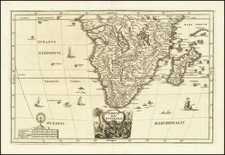
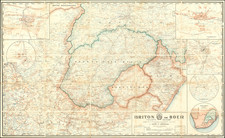
![[South Africa / Namibia / Angola] Coste Occidentale D'Afrique Depuis le XIe. Degre De Latitude Meridional, Jusqua'au Cap de Bonne Esperance Tiree de la Carte de l'Ocean Meridional . . . 1739](https://storage.googleapis.com/raremaps/img/small/77033.jpg)
